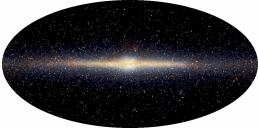
|
There are close to two hundred billion (200,000,000,000) stars in
the Milky Way Galaxy.

A gram of hydrogen contains roughly six hundred sextillion protons.
(Thats 600,000,000,000,000,000,000,000 protons).

The sun contains about two decillion grams of hydrogen.
(2,000,000,000,000,000,000,000,000,000,000,000 grams of hydrogen).

These are big numbers! (Check out a table of them here!) Can we even begin to conceive of numbers this
big? How about this: Can we calculate how many protons there are in
the Milky way Galaxy? Thats going to be a lot of zeros to carry through
in our multiplication!

Calculate the number of protons in the sun.
Can you calculate the number of protons in the
Milky Way galaxy?
 Dealing with numbers this big gets messy fast:
Can you and your lab partner arrive at a simpler scheme
for dealing with such big numbers? Dealing with numbers this big gets messy fast:
Can you and your lab partner arrive at a simpler scheme
for dealing with such big numbers?

What do we know about these large numbers that
might make manipulating them easier?
- Most of the information about their size comes from the
number of zeros they contain.
- Each zero represents a factor of ten increase in size. For
example, the number 100 is ten times as big as the number 10,
and 100 contains one more zero than 10. The number 1,000
(one thousand) is ten times as big as the number 100, and
1,000 contains one more zero than 100.
- The only additional piece of information is in the first
digit of the number, which can be any numeral from 1 through
9. The relative sizes of two numbers with the same number
of zeros is simply proportional to the first digit. For
example, eight thousand (8,000) is four times as large as
two thousand (2,000), and eight (8) is four times as large
as two (2).
In this lab and the lab that follows, we will see how the information
above is used to simplify manipulation of large numbers with the
use of "Scientific Notation".

Lets start by introducing the concept of an "exponent".
Since the number of zeros in a large number is the first clue
to its size, we might simplify a large number such as
a hundred sextillion by writing it as
| one hundred sextillion | = 100,000,000,000,000,000,000,000 |
| | = 1 followed by 23 zeros |
Now we also know that each zero represents a factor or "power" of ten:
| 10 | = 10 | (one power of ten) |
| 100 | = 10 x 10 | (two powers of ten) |
| 1,000 | = 10 x 10 x 10 | (three powers of ten) |
| 10,000 | = 10 x 10 x 10 x 10 | (four powers of ten) |
and so on. To remind us of the relation between the number of zeros
and the factors of ten, we can also write large numbers such as one hundred
sextillion as follows:
| one hundred sextillion | = 100,000,000,000,000,000,000,000 |
| | = 1 followed by 23 zeros |
| | = 1023 |
The number appearing in the "superscript" of the numeral 10 is
the power of ten of the number, the number of zeros in the number,
or the "exponent" of the number expressed in scientific notation.
In the following JAVA applets, you will have a chance to practice
the conversion of numbers between conventional notation (which you've
been using all your life, although you didn't know it was called that!)
and scientific notation.

- To start: Enter an exponent in the field next to 10 (please use numbers 0 through 23).
- Click the "Enter" button.
- Look at the information to see what the number you entered represents.
- Pay special attention to the multiples of ten and the number of zeroes in standard notation. (You'll be quizzed later!)
- To see another number, click the "Clear" button and start over. Repeat multiple times until you think you have a good grasp of the numbers.


- To start: Look and see which one of the fields has been filled out for you (the text will be in black).
- Fill out the rest of the fields based on the field in black.
- When you've filled out all the fields, click the "Check It" button.
- Correct answers will remain in blue, while incorrect answers will turn red.
- If you got everything right, click the "New" button to try a new problem.
- If you got a part wrong, you can try the same problem again by clicking the "Try Again" button.
- Go through multiple problems. See if you can get every field correct for each type of question.
- Good luck!


Now we can return to the question which motivated this lesson:
How can we use this notation to simplify the manipulation of
large numbers?
- Does the scheme for expressing large numbers in terms of
exponents suggest ways to simplify large multiplications
such as the number of protons in the galaxy?
- What relationship do you expect to find between the
exponents in the expression
10N x 10M = 10X
That is, can you find the relationship between N, M, and X?

MULTIPLICATION AND DIVISION OF SCIENTIFIC NOTATION
Optionally, you may join Sherlock and Watson to solve a mystery,
just follow the link to the next applet which will explain
the rules for multiplication and division of numbers expressed in
scientific notation.

Back to main Scientific Notation Page
© Copyright 2000-01
Montana State University
|
|


